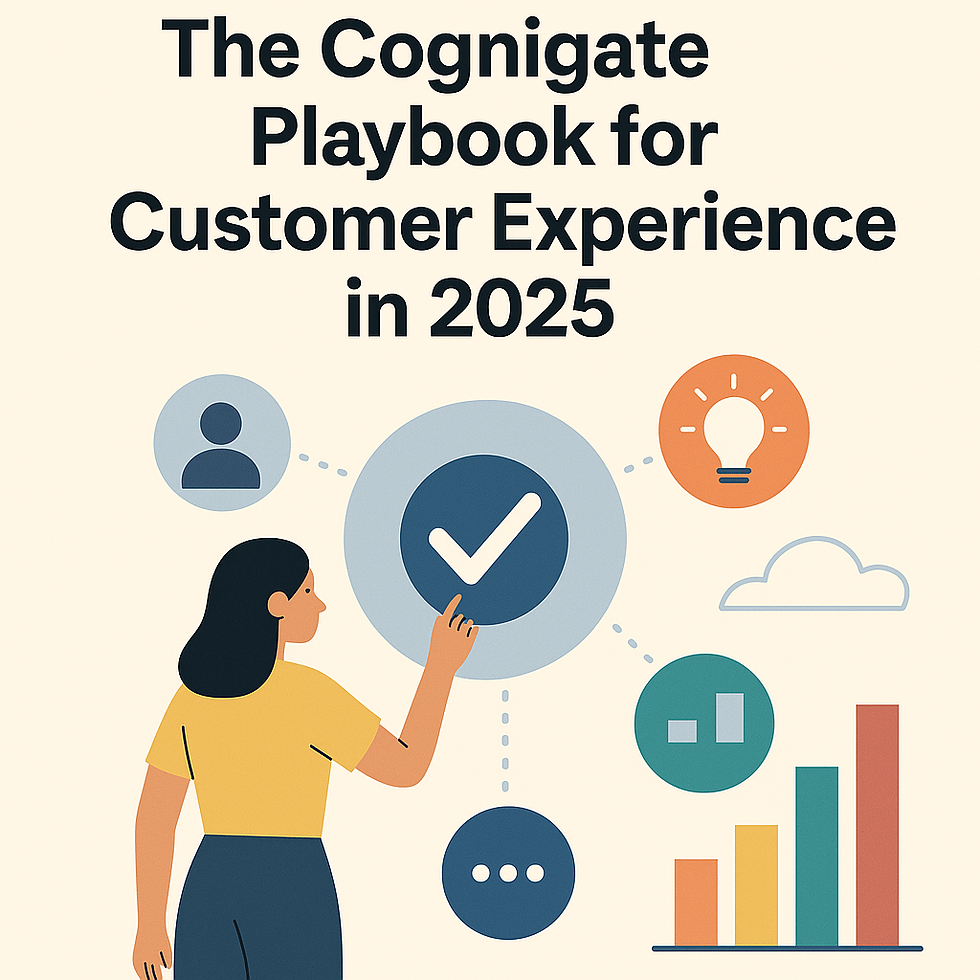- Cognigate Advisory Team

- Aug 27
- 3 min read
Updated: Aug 28

Introduction: Why Evaluation Matters More Than Ever
Across the Middle East, government and enterprise leaders are under intense pressure to digitize services and deliver value faster. But the challenge isn’t just issuing an RFP (Request for Proposal). The real challenge is ensuring that what’s procured delivers ROI (Return on Investment) — in citizen trust, employee productivity, and measurable business outcomes.
McKinsey highlights the problem:
“Organizations continue to spend heavily on digital and technology solutions, but only 30 percent of these transformations succeed.”
CIOs and CTOs need a structured playbook to evaluate not just vendors and tools, but the true value delivered after go-live. That’s where Cognigate’s approach comes in.
The Pitfall: RFP ≠ ROI
Too many projects in the region start with a compliance-driven RFP and end with shelfware (unused licenses, under-adopted platforms, wasted budgets).
PwC found that:
“Only 53% of executives are confident that their technology investments are achieving their intended results.”
The gap between RFP promises and ROI realities is wide. Evaluating solutions through the right lens is the CIO’s and CTO’s critical responsibility.
Cognigate’s 4-D Approach to Evaluation
Cognigate uses its 4-D Playbook to help clients evaluate solutions holistically:
Discover – Define real human and business needs before drafting RFPs.
Design – Structure evaluation criteria around HX, not just features.
Deliver – Ensure vendor commitments are tied to measurable adoption outcomes.
Drive – Track ROI post-implementation, using data-driven KPIs.
“Procurement should not be about buying software. It should be about investing in outcomes.” — Cognigate
Step 1: Discover — Define Needs, Not Features
Executives must avoid RFPs that are laundry lists of technical features. Instead, start with business outcomes:
Faster citizen response times (government)
Increased NPS or customer satisfaction (telecom/retail)
Seamless student journeys (education)
Gartner advises:
“Organizations should focus on business outcomes and how technology can enable them, rather than evaluating features in isolation.”
Cognigate Example: In one UAE RFP, instead of focusing on 200+ feature requirements, we worked with the client to frame KPIs around adoption rates and time-to-value.
Step 2: Design — Build HX Into Evaluation Criteria
Too often, RFP scoring models overemphasize cost or technical compliance. By 2025, successful CIOs will weight evaluation criteria toward human experience (HX):
Usability and adoption potential
Employee experience for those delivering CX
Integration simplicity (does it connect to ERP, HRMS, legacy systems?)
Data transparency and analytics
Accenture notes:
“81% of organizations agree that failing to adopt a human-centered approach puts transformation success at risk.”
Cognigate Perspective: We advocate including “HX impact” as a formal weighted criterion in every evaluation matrix.
Step 3: Deliver — Tie Commitments to Adoption
A common RFP pitfall is vendors promising everything during sales cycles and disappearing after signature. To avoid this, evaluation should:
Tie payment milestones to adoption metrics, not just delivery checklists.
Require vendors/system integrators to demonstrate working proof-of-concepts (POCs).
Mandate change management and user training plans in bids.
Forrester stresses this:
“Technology investments fail when adoption lags. Success must be measured in outcomes, not project completion.”
Cognigate Practice: In every bid, we align “go-live success” to actual usage dashboards (tickets resolved, OKRs tracked, workflows automated).
Step 4: Drive — Measure ROI Beyond Go-Live
The final stage is ensuring ROI is captured continuously:
Define ROI in terms of HX improvements (reduced waiting times, employee productivity).
Embed analytics and dashboards to track ROI in real time.
Establish quarterly “ROI councils” with vendor + customer teams to review progress.
Deloitte research in the Middle East underscores this:
“Organizations with strong post-implementation governance realize ROI 2–3x faster than those without.”
The Buyer’s Playbook: CIO/CTO Checklist
Before the RFP
Define KPIs linked to business strategy.
Engage end-users in journey mapping.
Benchmark against regional peers.
During the RFP
Include HX as weighted criteria.
Demand integration and compliance transparency.
Tie evaluation to POCs, not PowerPoints.
After Vendor Selection
Tie payments to adoption milestones.
Sponsor change management initiatives.
Mandate transparent ROI dashboards.
Post Go-Live
Launch quarterly ROI reviews.
Embed metrics into leadership scorecards.
Reinvest savings into innovation pilots.
Conclusion: From Paper to Performance
Issuing an RFP is easy. Achieving ROI is hard. CIOs and CTOs who succeed will be those who:
Discover real needs before writing requirements.
Design evaluations that prioritize human experience.
Deliver contracts tied to adoption, not just delivery.
Drive outcomes long after go-live.
As Harvard Business Review put it:
“Digital transformation is the CEO’s job. Only the CEO can make the fundamental changes required.”
At Cognigate, we believe: RFPs are just documents. ROI is the proof of transformation.


